Invisalign® – Auburn, ME
Discreet and Convenient Orthodontic Treatment
Misaligned teeth pose a threat to your oral health. Not only can they trap food and be a major factor in decay, but they can also interfere with your bite and contribute to TMJ disorder. Plus, crooked teeth are not as attractive as straight ones. Orthodontic care can address all of these issues. At Willow Run Dental Association, we are proud to offer Invisalign® in Auburn. If you are interested in finding out whether this convenient, discreet, and effective treatment is right for you, contact us to schedule your consultation. In the meantime, you can discover more about Invisalign® by reading the information below.
Why Choose Willow Run Dental Association for Invisalign®?
- Experienced Dental Team
- Discreet Orthodontic Treatment
- Flexible Payment Options
How Invisalign® Works
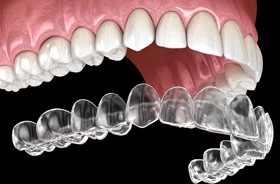
Traditional metal braces work by applying gentle, sustained pressure to the teeth. As the braces get tightened little by little over time, the teeth gradually move into their ideal positions. Invisalign® also applies pressure to the teeth. However, instead of using metal brackets and wires, it uses a series of custom-made, clear aligners. You simply wear each aligner for 20 – 22 hours each day for two weeks before you move onto the next. Once you have worn all the aligners, your teeth should be exactly where they ought to be.
You can get started with Invisalign® by visiting us for a free consultation, wherein we will evaluate your candidacy for Invisalign®, answer all of your questions, and discuss the future course of your treatment. If you decide to move forward, we will take detailed images and impressions of your teeth, which will serve as the basis for designing your custom aligners. Once you begin wearing the aligners, you will need to visit us periodically for brief checkup visits.
Who Can Invisalign Help?

Invisalign is able to address most mild to moderate orthodontic problems, including malocclusions (bad bite), gapped teeth, rotated teeth, and more. To find out for sure if it might be able to benefit you, you will need to attend a consultation so we can evaluate the details of your case. In the meantime, here is an overview of some of the issues that Invisalign is commonly used to treat:
Crowded Teeth
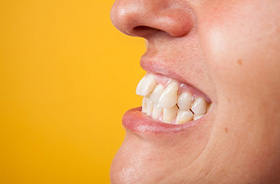
Crowded, overlapping teeth can trap food between them, increasing your risk of decay and gum disease. They may also make you feel self-conscious about your appearance. Invisalign, often with the help of extractions, can usually shift the teeth so each one has the space it needs to thrive.
Gaps Between Teeth

Extra space between the teeth may seem cute and quirky, but their appearance can be deceptive. Large gaps between your teeth leave your gums vulnerable to harm and can interfere with your bite. Invisalign may be able to close or reduce those gaps to give you a healthier, more functional smile.
Overbite
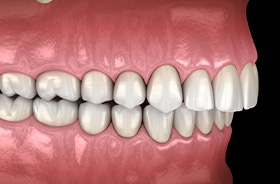
An overbite occurs when the top teeth protrude in front of the bottom teeth. A small overbite is normal and healthy. However, if an overbite is too extreme, it can lead to speech problems, uneven wear and tear on your teeth, and aesthetic issues. Invisalign, usually with the help of special accessories, can sometimes treat an overbite.
Underbite
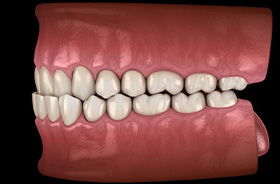
An underbite is when the bottom front teeth protrude in front of the top teeth. Often, this issue is caused by genetics, traumatic injuries, or certain non-nutritive habits during childhood, such as prolonged thumb-sucking. Often, Invisalign can address an underbite, particularly if accessories like rubber bands are used to train the lower jaw to rest in the correct position.
Crossbite
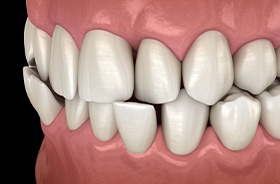
When some of the bottom teeth overlap the top teeth, it is known as a crossbite. This problem is sometimes the result of genetics, bad habits, or premature loss of the baby teeth. An untreated crossbite can increase the risk of tooth breakage and interfere with your bite and facial aesthetics. Invisalign is often able to correct a crossbite and promote more harmonious oral function.
Open Bite
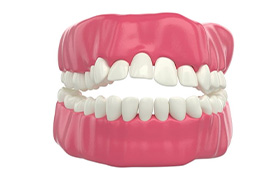
If your front bottom and top teeth do not touch one another even when your back teeth are making contact, you have an open bite. An open bite may occur due to poor bone development or bad habits during childhood, such as thumb-sucking. Because an open bite can lead to speech problems and other complications, treatment is important. Invisalign is a valid option for many people who have this issue.
Benefits of Invisalign
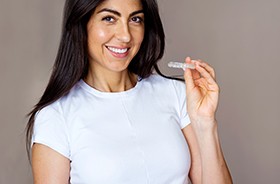
Invisalign is an astonishingly popular orthodontic treatment option. Countless people choose it over other teeth-straightening methods. Do you know why it has attracted so many patients? Simply because it offers a range of benefits that are not available from traditional braces. Would you like to know more about the advantages that Invisalign has to offer? When you come in for a consultation, we can share details that are pertinent to your unique situation. In the meantime, you can get some generalized insight by reading the information below.
Improved Comfort
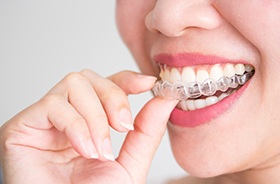
Invisalign aligner trays are made of smooth plastic, so you can expect them to sit comfortably against your gums. There are also no protruding brackets and wires to irritate your lips or cheeks. Plus, because Invisalign moves the teeth a bit more gradually than metal braces, you can expect less discomfort as your teeth get shifted into their new positions.
Discreet Appearance

If you are an image-conscious person, you may want your orthodontic treatment to be as discreet as possible. Invisalign trays are almost invisible when they are placed on the teeth, so they are unlikely to be the first thing that other people notice about your appearance. It is even okay to remove them for photoshoots or other special occasions.
Easier Dental Hygiene

With traditional braces, it is necessary to navigate around brackets and wires in order to keep your teeth clean. That can be somewhat tedious. Invisalign makes things easier. Because the trays are removable, you can simply take them out of your mouth before you brush and floss by using normal techniques.
Eat Your Favorite Foods

Regular metal braces come with a substantial list of dietary restrictions. Some of your favorite snacks might be off-limits with them! Invisalign trays are easy to remove. As long as they are not in your mouth, you can feel free to eat virtually anything, including items like pizza, popcorn, and other foods that are challenging to consume with traditional braces.
Quick Check-Ins
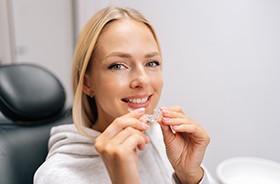
Invisalign appointments take place every 6 – 8 weeks or so. They are usually very brief, often lasting just 15 – 30 minutes. Because there are no wires for us to change, you can expect a very comfortable experience as we monitor your progress, provide additional aligners, and address your questions.
Treatment That Fits Your Lifestyle

As someone with a busy and active lifestyle, you want your orthodontic treatment to fit into your daily rhythm. Invisalign can do that. It is designed to have a minimal impact on your daily habits. Although you may need to make some minor adjustments, most people find it very easy overall to incorporate Invisalign into their regular routine.
Understanding the Cost of Invisalign
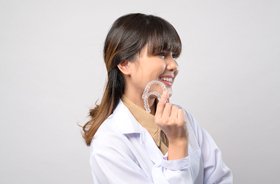
When you visit your Invisalign dentist in Auburn for a complimentary consultation, we will be able to provide you with a price estimate for your treatment. Most patients spend at least a few thousand dollars for orthodontic care. Your total cost will be based on how many aligners you require and other factors. Our team can help you explore your options for making Invisalign® as affordable as possible, such as insurance and financing.
Factors that Affect the Cost of Invisalign
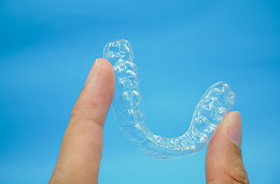
The cost of Invisalign in Auburn depends on several factors, including:
- The number of aligners needed. This is influenced primarily by the extent of your dental misalignment. Whether you are straightening one dental arch or both also has an impact on the number of aligners you will need. Replacement aligners for ones that incur damage or get lost incur their own fees.
- Whether any accessories are needed. Some patients require buttons for their aligners or other attachments to enjoy successful treatment.
- Compliance with treatment guidelines. Not wearing the aligners as much as recommended or making other missteps could extend your treatment timeline and add to overall costs.
Invisalign vs. Mail-Order Clear Aligners: Understanding Cost vs. Value
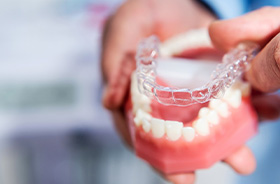
In recent years, mail-order clear aligners have seen a boom in popularity. Their appeal is understandable. After all, they cost much less than Invisalign, and they do not require you to make trips to a local dental office.
However, it is important that you consider what you are getting for your money. With Invisalign, you enjoy the personalized support of a highly trained team of dental professionals. Mail-order aligners are less personal, and you may not be able to get prompt help if you encounter a problem with your treatment. Additionally, mail-order companies might ask you to take your own dental impressions. Even a small mistake while doing so could lead to unsatisfactory treatment results.
Other potential differences between Invisalign and mail-order aligners include the materials used, the predictability of treatment, and more. Because of the many advantages offered by Invisalign, it is generally a wiser choice than mail-order options.
Does Dental Insurance Cover Invisalign?
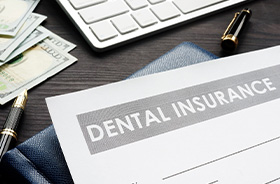
Insurance coverage for orthodontia is included in some premium plans. In most cases, these policies have a lifetime maximum for orthodontic care, and Invisalign is usually included. If your policy has such a provision, we will be happy to help you navigate your benefits and file your claims. If your plan does not apply to Invisalign, you might consider alternative methods for paying for your treatment, such as your flexible spending account or healthcare savings account.
Options for Making Invisalign Affordable

We would like to help you afford Invisalign in Auburn. To that end, we offer a few useful provisions:
- FREE initial consultation. Learn more about Invisalign for absolutely nothing out of pocket.
- CareCredit is a third-party lender that offers low-interest financing for medical and dental care. The application process is quick, and most patients qualify for credit.
- Essential Dental Plan. This discount plan provides reduced fees on most of the services we offer.
Would you like to learn more about Invisalign and its cost? Contact us today to schedule your consultation. We look forward to serving you!
Living with Invisalign Aligners

When you receive your Invisalign aligners, you will need to make some adjustments to your routine! Your good habits will support the success of your treatment and help you avoid unnecessary delays. What specific steps will you need to take? Our team will provide you with detailed instructions. In the meantime, you can continue reading below to learn some basic best practices that you should apply throughout your time with Invisalign.
Wearing Your Trays
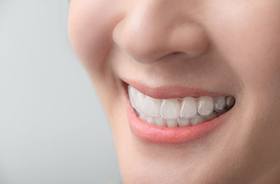
Invisalign aligners only work when you are wearing them, so it should be your goal to keep Invisalign in your mouth for a minimum of 20 – 22 hours each day. You should only remove them when you eat, drink anything other than plain water, or need to perform oral hygiene tasks.
If you fail to wear your aligners for the recommended amount of time, your teeth may not move as they should. Subsequent aligners could feel unusually tight or even be unwearable!
Cleaning Your Aligners
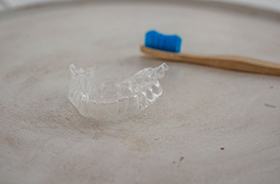
Keeping your aligners clean can prevent bacteria, stains, and odors from collecting on them. You should:
- Rinse your aligners right before placing them in your mouth.
- Soak your aligners for 15 – 30 minutes a day using Invisalign cleaning crystals or another mild cleaning solution.
- Gently brush your aligners with a soft brush and clear soap.
- Keep your mouth fresh and healthy by sticking to a thorough brushing and flossing routine. (Ideally, you should clean your mouth after each meal.)
Eating & Drinking

The only thing you should consume while wearing Invisalign is plain water. Otherwise, you might end up staining or damaging your aligners.
When you remove your aligners, however, you can feel free to enjoy any foods or beverages you want. Just make sure your Invisalign trays are properly stored while you are eating. After you finish your snack or meal, clean your teeth and rinse your aligners before placing them back in your mouth.
Losing or Damaging a Tray

If a tray becomes unusable because it gets lost or damaged, call our office. We might need to order a replacement for you. In the meantime, you may need to go back to wearing a previous aligner. Alternatively, we might advise you to move onto your next aligner a few days later. (You should not do so without explicit direction from our team — switching aligners too early could cause discomfort and other complications.)
Routine Check-Ins
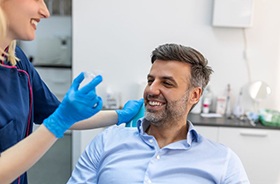
We usually advise patients to visit us every 4 – 8 weeks for an Invisalign checkup. During these brief appointments, we will check on your progress, address any questions or concerns you may have, and provide you with the next set of aligners in your treatment.
If we ever determine that some adjustments need to be made to your treatment plan, we may have to order additional aligners for you so your teeth can stay on track toward their final destinations.
Invisalign FAQs
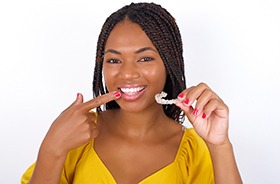
As your cosmetic dentist in Auburn, our team is ready and eager to help you find answers to all of your questions about Invisalign. Before you schedule your consultation with us, however, you may want to do some reading on your own to find out more about this treatment. To help you out, we have compiled answers to some Invisalign FAQs. Take a look, and make a note of anything you would like further explanation on — we want all of our patients to be well-informed before they commit to anything.
How Long Does Invisalign Take?
On average, Invisalign takes about 12 months. Your treatment time could be significantly longer or shorter than that; it depends primarily on the extent of your dental misalignment. Some relatively simple cases take just 6 months or so to correct, while more severe issues may require at least 18 months of treatment. During your consultation, we will be able to estimate how long you will have to wear Invisalign before you achieve your desired results.
Does Invisalign Hurt?
Invisalign in Auburn is designed to be as comfortable as possible. The aligners are constructed out of a thin plastic material, and their edges are smoothed out so they do not irritate the gums. There are no metal parts to cause sores on the cheeks or tongue.
With that being said, it is important to remember that the aligners apply consistent pressure to the teeth. Naturally, that can cause a degree of soreness and tenderness. To alleviate any discomfort, you can sip on cold water and take pain relievers as necessary. You can also try switching to each new aligner at night. Doing so allows you to sleep through the initial part of the adjustment period, when Invisalign discomfort is likely to be its greatest.
What Happens After Invisalign?
Once you work your way through all of your aligners, you will transition into the retention stage of treatment. That is to say, you will have to wear a retainer to prevent your teeth from drifting back toward their former positions. If you have a removable retainer, you should wear it full time at first (20 – 22 hours each day). Later, you may need to wear it only at night. Eventually, you might be required to use it for just a few nights each week.
What if My Invisalign Broke?
If an aligner has hairline fractures, you might be able to continue using it. Just be extra-cautious when taking it in and out of your mouth. If the damage is more severe, call our practice. We might advise you to switch to a new aligner a few days early. Alternatively, you may have to wear a former aligner while we order a replacement for the broken one. Do not try to repair a broken aligner with superglue or any other substance that is not meant to be used in the human mouth.
What Do Invisalign Trays Look Like When Worn?
Invisalign aligner trays are made of clear plastic. Even though they are not completely invisible when placed on the teeth, they do not call a lot of attention to themselves. Onlookers are likely to notice your smile before they notice your treatment! With that being said, you may find that your teeth look a bit bigger than usual.
Also, if you have buttons or attachments on your Invisalign, they may not be clear, so onlookers might notice them.
What Are Invisalign Attachments?
Invisalign attachments are small, tooth-colored bumps that we sometimes must attach to teeth in order to guide the force of the aligners. This allows for more efficient tooth movements. The attachments are made out of a biocompatible material, and they are usually removed at the end of treatment (sometimes sooner).
Attachments are a fairly recent innovation for Invisalign treatment. In the past, the aligner trays could only be used for relatively minor cases of misalignment. However, thanks to attachments and other accessories, they are now suitable for a wide range of orthodontic issues.
Who Is Not Eligible for Invisalign?
While Invisalign is a great choice for many teens and adults with mild to moderate dental misalignment, there are some people for whom it is not suitable:
- Children under the age of 13.
- People with certain types of severe or complex dental misalignment.
- Individuals who smoke or chew tobacco. (Cigarettes and chewing tobacco can stain the aligners and endanger your oral health.)
- Patients with particularly small, misshapen, or eroded teeth. If you have such issues, you may need restorative dental care before moving forward with orthodontia.
To find out if Invisalign is right for you, attend a consultation with our team.
How Do I Take Off Invisalign Trays?
Removing Invisalign trays can be easy once you master your technique. Here are a few tips:
- Start out with dry hands.
- Gently remove the aligner from the back molar on one side of your mouth, then go to the other side. Switch back and forth as you work your way toward the front of your mouth.
- If needed, use a paper towel or Invisalign PulTool to remove the aligners. The PulTool has a convenient hook that can help get the aligners off the back teeth.
- Do not try to remove your aligners immediately after drinking cold water. The lower temperature can cause the trays to become less flexible.
How Do I Clean My Invisalign?
Invisalign sells its own cleaning system, which includes special cleaning crystals that you can use to soak your aligners daily. They also sell a product called Steraligner, which is a liquid cleaning system designed to remove plaque and bacteria.
Of course, you may not need any special products to keep your trays clean. You can simply brush them daily with a soft brush and mild, unpigmented soap. You should also rinse them regularly throughout the day.
You should never clean your aligners with hot water because the high temperature could cause them to warp.
